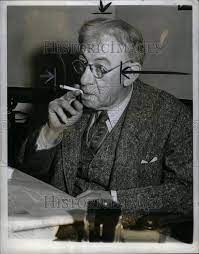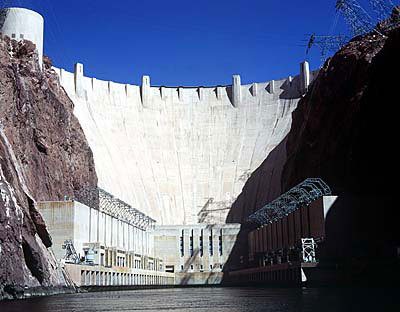The Colorado River is a mighty one, taking eons to carve out the Grand Canyon.
HH: The Great Engineer
Herbert Hoover (1874-1964) was a true Horatio Alger story. Born to a poor farmer-blacksmith in rural Iowa, he was totally orphaned by ten, and farmed out to relatives in Oregon. They were kind to him, but it was a lonely adolescence. In high school, he took a summer job at an engineering firm, asked a million questions, and decided that engineering would be his career choice.
When he graduated, Stanford University in Palo Alto, CA had just opened its doors. Tuition was free. But with only a small amount of “seed money” for room, board, books and sundries, he had to take on a variety of part-time positions. With his own natural talents, a willingness to assume responsibility and work hard, he earned a reputation as someone to “keep an eye on.”
His professors liked him and made sure he was introduced to all the major mining interests in the west.
When he graduated however, the country was in the midst of a serious economic recession and the “major mining interests” had no openings, although they urged him to contact them again in a few months. But he needed money to live on and could not wait. So he took the only available opening – pushing an ore cart in the mines for 10 hours a day, six days a week – paying a sumptuous $12/week. The miners liked him – he asked a million questions. The owners liked him too. He worked hard and never complained.
Within six months he had a better position that paid $2000/year. In four years, he was earning $40,000/year. That same year, 1899, the President of the United States earned $50,000/year. By the time he was 40, Hoover was a millionaire several times over.
The Great War and Change of Career
When the Great War (WWI) began in Europe in 1914, Hoover was a world renowned mining consultant living in London, with offices in six countries. Asked by some friends to “volunteer” sorting out transportation problems for his fellow-Americans, Herbert Hoover found a new life choice: humanitarianism on a grand scale.
It was only a matter of time before President Woodrow Wilson summoned him home to manage some war efforts in the USA. Hoover hadn’t lived in America since he graduated from Stanford.
He was happy to return. With a solid private income, he divested most of his professional mining interests, and devoted his time to philanthropy.
Again, it was only a matter of time before high political office fell into his lap. Under both Presidents Harding and Coolidge, he served as Secretary of Commerce.
The Dam
Damming the Colorado River had been on the minds of engineers for decades. The river was wild, flooded regularly, and wreaked havoc on the ranchers and farmers and town dwellers in the southwest. After the Great War, the technology had caught up with the need, and plans for the great project were undertaken.
It fell under the auspices of the Department of Commerce, and it understandably became Hoover’s pet project. It is a fair assumption, that had HH not been Secretary of Commerce, he would have been engaged as an expert consultant at some (or various) points of the project.
The actual construction of the huge dam began in 1931, when Hoover was President. By Act of Congress, it was to be called the Hoover Dam.
Undermining the Dam
Unfortunately, the Hoover administration coincided with the start of the Great Depression – a severe economic downturn lasting more than a decade. For all his skills and talents as a great organizer, and his own personal philanthropy (he never took a salary for his public services), Hoover lacked the political and personal skills to inspire a populace that was become more and more despondent.

By 1932, when the country was in the depths of economic woes, Hoover was up for re-election against Franklin D. Roosevelt, a charismatic opponent with a broad grin and a famous name. The Democratic National Committee had also engaged its first paid publicity director, Charles Michelson.
Michelson, a western newspaper reporter past sixty at the time, devised a powerful theme: Make Hoover’s name synonymous with Hoovervilles – the shantytowns for unemployed homeless cropping up in virtually every city. According to Michelson, to do that most effectively, Hoover’s name and the mighty engineering marvel harnessing the Colorado River needed to be completely disassociated.
Through dozens of newspaper and magazine stories, the dam under construction was constantly referred to as “the dam in Boulder.” Boulder, Nevada was a tiny town, population not-a-lot, but would grow by several thousand, once the workers, their families and ancillary services moved in. And “the dam in Boulder” was repeated over and over during the next four years until it became Boulder Dam – featured as Boulder Dam on the maps and the guidebooks and the newsreels and the picture postcards.

The fact that it was originally called the Hoover Dam was all but forgotten by the time it opened in 1935. The former President wasn’t even invited to the ceremonies.
Hoover, characteristically, did not complain, nor did he ever hold it against FDR personally. But according to the archivists at the Herbert Hoover Presidential Site, he had a blue porcelain Chinese bowl featuring a fierce dragon – and he named it “Charlie.”
Correction…
A dozen years passed before Boulder Dam was rechristened.
After FDR died, Harry S. Truman, overwhelmed by the responsibilities on his new plate, reached out to the only living former President, who was happy to be of service. The two men, both midwestern farm boys who grew up the hard way, formed a deep and lasting friendship, and in 1947, Boulder Dam was formally renamed the Hoover Dam. On the maps and the guidebooks and newsreels and postcards. And T-shirts.
Go see it. It is truly an engineering marvel.
Sources:
Smith, Richard Norton – An Uncommon Man: The Triumph of Herbert Hoover – Simon and Schuster, 1984
http://www.hoover.archives.gov/info/HooverBio.html
https://www.history.com/topics/great-depression/hoover-dam
https://millercenter.org/president/hoover/life-before-the-presidency





Reblogged this on Dave Loves History.
I saw the Hoover when I was in Arizona over 20 years ago. It’s something to see and if people are going to Arizona to see the Grand Canyon, they should definitely take time to see the Hoover Dam.
I always thought President Hoover was a victim of dirty politics. It’s too bad. He wanted to do something for the people during the Depression but political opponents blocked him so he would be blamed for it. Even back then, people would rather play politics than work together to fix things. It really was too bad.